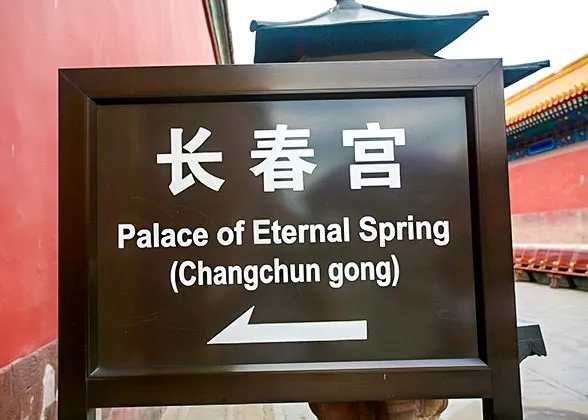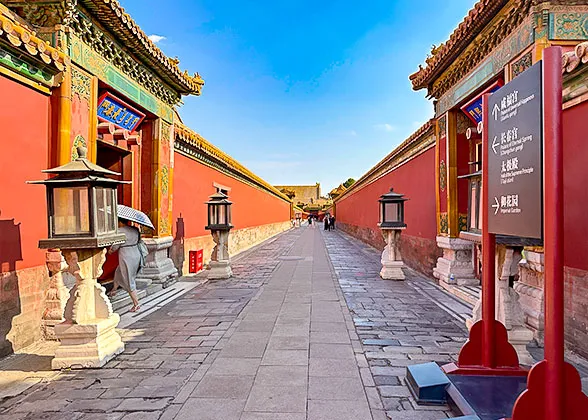Palace of Eternal Spring (Changchungong)
 |
| Eternal Spring Palace Signpost |
Best known as Empress Dowager Cixi's (1835~1908) living quarter, the complex features a main hall, rear hall, front stage, and flanking eastern and western side halls arranged within a courtyard.
Architectural Highlights
Connected Layout Breaks Palace Symmetry
In 1859, to celebrate his 30th birthday and decade-long reign, Emperor Xianfeng merged the Palace of Eternal Spring and Hall of Supreme Principle into a lavish four-courtyard complex for his living. Unlike the separate courtyards of the Six Eastern Palaces, this bold redesign disrupted the Forbidden City's traditional symmetry.
Stage in the Front Courtyard
A key feature of Xianfeng's renovation was the canopied stage extending from Supreme Principle Hall’s rear to Eternal Spring Palace's front courtyard. Qing royals loved to enjoy Peking Opera here. Even in cold winter, performances continued on the stage, which would be surrounded by glass walls for warmth. In 1874, for Empress Dowager Cixi's 40th birthday, the stage hosted performances lasting for 15 days. Other parts of the palace was further adorned with over 300 luxury items like carpets, drapes, and embroidered furnishings, all transforming into a grand celebration scene.
Murals along the Main Hall's Corridor
Along the side corridors of main hall, ten exquisite murals bring to life scenes from Dream of the Red Chamber, a classical 18th-century Chinese novel that exposed the harsh realities of feudal society. These paintings capture both pleasant moments—such as young ladies playfully chasing butterflies or reclining among flowers—and grand scenes like extravagant birthday celebrations and dreamlike fairyland.
At each end of the corridors, two panoramic murals create a striking illusion. The eastern mural depicts a figure with his back turned, as if stepping into the novel's world. The western mural, in contrast, shows him facing outward, as though completing his journey through the painted story’s scenes and returning to reality. Facing with them, you will experience a surreal blurring of art and life.
Who Lived in the Palace of Eternal Spring?
Concubine Cheng: Cleverly Surviving from Starvation
 |
| Way to Eternal Spring Palace |
Concubine Cheng (1605~1637), who once resided in the Palace of Eternal Spring, was a kind and clever woman in the ruthless court.
When another concubine was imprisoned after losing favor, Cheng pleaded with the emperor for mercy. But the emperor was a puppet ruler, and the real power lay with his mother and the Chief Eunuch, whom the disgraced concubine had offended. Enraged by Cheng’s interference, they imprisoned her in the Palace of Eternal Spring without food.
Unknown to them, Cheng had prepared for the moment by storing dried food between the roof tiles and survived on them. When people came to retrieve her corpse on the 15th day of her imprisonment, they were shocked to find her alive. Believing divine intervention had spared her and fearing heavenly retribution, they ultimately set her free.
Empress Xiaoxianchun: Emperor Qianlong's Deeply Loved One
From 1735 to 1748, the Palace of Eternal Spring was home to Empress Xiaoxianchun, the woman Emperor Qianlong (1711~1799) deeply adored.
The empress's name, which means kindness and respect for elders, perfectly describes her traits. She took great care of Qianlong's mother and treated other concubines' kids as her own, despite losing three of her own children. When Qianlong was injured, she stayed by him every night and changed the wound dressings in person until he recovered.
Following Empress Xiaoxianchun's passing in 1748, Qianlong ordered the Palace of Eternal Spring to remain untouched, and visited here annually to mourn her, a tradition that lasted over 40 years and an act earning the place the nickname "the most affectionate palace".
Empress Dowagers Cixi and Ci'an: Ruling behind a Screen
When Emperor Xianfeng died in 1861, Ci'an, his empress, and Cixi, his successor Emperor Tongzhi's (1856~1875) birth mother, governed the empire from behind a screen in Eternal Spring Palace until 1871, when Tongzhi nominally assumed power though still under their influence.
The two empress dowagers' partnership seems to be fragile. According to palace records, after eating pastries presented by Cixi at the Palace of Eternal Spring, Ci'an collapsed with violent stomach pains and died, which fueled speculation that Cixi had poisoned her co-regent to consolidate power.
Wenxiu: The Last Imperial Concubine Living Lonely in the Palace
In 1921, Wenxiu (1909~1953), just under 13, became the last occupant of the Palace of Eternal Spring when she was chosen as a concubine to Puyi (1906~1967), the last emperor of the Qing Dynasty.
Wenxiu's marital life was far from happy. The once bustling Forbidden City at that time felt like an old desolate island, and she was often found fault by the empress. Fortunately, she sought solace in reading and writing, and poured sorrow into ink. From a handwriting of her, experts found Wenxiu likened herself to a deer at the mercy of fate, as she endured the long lonely days and nights in the Forbidden City.
See more Six Western Palaces
- Last updated on Sep. 30, 2025 by Jally Zhang -